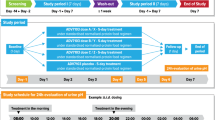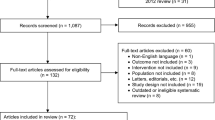Abstract
-
▲ Extended-release oxybutynin (Ditropan XL®1) uses an osmotic system (OROS®) to deliver a controlled amount of oxybutynin chloride into the gastrointestinal tract over a 24-hour period when taken once daily.
-
▲ Oxybutynin binds to M3 muscarinic receptors on the detrusor muscle of the bladder, preventing acetylcholinergic activation and relaxing the muscle.
-
▲ Mean peak plasma concentrations are lower with extended-release oxybutynin 15mg once daily than with conventional immediate-release oxybutynin 5mg taken 3 times daily. Relative bioavailabilities of parent drug and metabolite N-desethoxybutynin are 153 and 69%, respectively, for extended-release oxybutynin when compared with immediate-release oxybutynin.
-
▲ In short (≤6 weeks) randomised, double-blind clinical trials of patients with detrusor instability, extended-release oxybutynin 5 to 30mg once daily significantly reduced the mean weekly number of urge incontinence episodes by 84 to 90%. Extended-release oxybutynin had similar efficacy to immediate-release oxybutynin.
-
▲ Adverse events reported by patients taking extended-release oxybutynin were dose-related anticholinergic effects, most frequently dry mouth, somnolence, constipation, blurred vision and dizziness.
-
▲ A large noncomparative study demonstrated that approximately two thirds of the patients prescribed extended-release oxybutynin for detrusor instability were still taking the medication 6 months later.



Similar content being viewed by others
References
Yarker YE, Goa KL, Fitton A. Oxybutynin: a review of its pharmacodynamic and pharmacokinetic properties, and its therapeutic use in detrusor instability. Drugs Aging 1995 Mar; 6: 243–62
Chutka DS, Fleming KC, Evans MP, et al. Urinary incontinence in the elderly population. Mayo Clin Proc 1996 Jan; 71: 93–101
Chutka DS, Takahashi PY. Urinary incontinence in the elderly: drug treatment options. Drugs 1998 Oct; 56: 587–95
Fantl JA. Behavioural intervention for community-dwelling individuals with urinary incontinence. Urology 1998; 51 Suppl. 2A: 30–4
Wagg A, Malone-Lee J. The management of urinary incontinence in the elderly. Br J Urol 1998 Dec; 82 Suppl. 1: 11–7
Portera SG, Lipscomb GH. Pharmacologic therapy for urinary incontinence and voiding dysfunctions. Clin Obstet Gynecol 1998 Sep; 41: 691–701
Appell RA. Electrical stimulation for the treatment of urinary incontinence. Urology 1998; 51 Suppl. 2A: 24–6
Appell RA. Surgery for the treatment of overactive bladder. Urology 1998; 51 Suppl. 2A: 27–9
Urinary Incontinence in Adults Guideline Update Panel. Urinary incontinence in adults: acute and chronic management. Agency for Health Care Policy and Research, Public Health Service, US Department of Health and Human Services, 1996. AHCPR publication no. 96-0682
Appell R, Chancellor M, editors. Once-a-day Ditropan XL® (oxybutynin chloride) extended-release tablets 5mg and 10mg: product monograph. Palo Alto (CA): ALZA Corporation, 1999
Levin RM, Wein AJ. Direct measurement of the anticholinergic activity of a series of pharmacological compounds on the canine and rabbit urinary bladder. J Urol 1982; 128(2): 396–8
Smith ER, Wright SE, Aberg G, et al. Comparison of the antimuscarinic and antispasmodic actions of racemic oxybutynin and desethyloxybutynin and their enantiomers with those of racemic terodiline. Arzneimittel Forschung 1998 Oct; 48: 1012–8
Noronha-Blob L, Kachur JF. Enantiomers of oxybutynin: in vitro pharmacological characterization at M1, M2 and M3 muscarinic receptors and in vivo effects on urinary bladder contraction, mydriasis and salivary secretion in guinea pigs. J Pharmacol Exp Ther 1991 Feb; 256: 562–7
Kachur JF, Peterson JS, Carter JP, et al. R and S enantiomers of oxybutynin: pharmacological effects in guinea pig bladder and intestine. J Pharmacol Exp Ther 1988 Dec; 247: 867–72
Tonini M, Rizzi CA, Perucca E, et al. Depressant action of oxybutynin on the contractility of intestinal and urinary tract smooth muscle. J Pharm Pharmacol 1987 Feb; 39: 103–7
Yono M, Yoshida M, Takahashi W, et al. Comparison of various antimuscarinic drugs on human detrusor smooth muscles [abstract no. 175]. J Urol 1999 Apr; 161 Suppl.: 48
Yamaguchi O, Shishido K, Tamura K, et al. Evaluation of mRNAs encoding muscarinic receptor subtypes in human detrusor muscle. J Urol 1996; 156(3): 1208–13
Moore KH, Hay DM, Imrie AE, et al. Oxybutynin hydrochloride (3mg) in the treatment of women with idiopathic detrusor instability. Br J Urol 1990 Nov; 66: 479–85
Tapp AJS, Cardozo LD, Versi E, et al. The treatment of detrusor instability in postmenopausal women with oxybutynin chloride: a double-blind placebo-controlled study. Br J Obstet Gynaecol 1990 Jun; 97: 521–6
Gupta SK, Sathyan G. Pharmacokinetics of an oral once-a-day controlled-release oxybutynin formulation compared with immediate-release oxybutynin. J Clin Pharmacol 1999 Mar; 39: 289–96
Alza Corporation. Ditropan XL® (oxybutynin chloride) extended-release tablets prescribing information. Palo Alto (CA), 1999
Yaich M, Popon M, Medard Y, et al. In-vitro cytochrome P450 dependent metabolism of oxybutynin to N-desethyloxy-butynin in humans. Pharmacogenetics 1998 Oct; 8: 449–51
Waldeck K, Larsson B, Andersson K-E. Comparison of oxybutynin and its active metabolite, N-desethyl-oxybutynin, in the human detrusor and parotid gland. J Urol 1997 Mar; 157: 1093–7
Paine MF, Khalighi M, Fisher JM, et al. Characterisation of interintestinal and intraintestinal variations in human CYP3A-dependent metabolism. J Pharmacol Exp Ther 1997; 283(3): 1552–62
Versi E. Improving urge incontinence treatment by decreasing dry mouth with controlled-release oxybutynin [abstract poster]. Obstet Gynecol 1999 Apr; 93 Suppl.: 78
Zinner NR. Patient-oriented outcomes with once-daily oxybutynin for urge incontinence [abstract]. Obstet Gynecol 1999 Apr; 93 Suppl.: 29
Anderson RU, Mobley D, Blank B, et al. Once dailycontrolled versus immediate-release oxybutynin chloride for urge urinary incontinence. OROS® Oxybutynin Study Group. J Urol 1999 Jun; 161: 1809–12
Gleason DM, Susset J, White C, et al. Evaluation of a new once-daily formulation of oxybutynin for the treatment of urinary urge incontinence. Urology 1999 Sep; 54: 420–3
Labasky R, Leach G, Antoci J. Long-term experience with once-a-day extended-release oxybutynin in a communitybased population treated for overactive bladder [abstract]. 29th International Continence Society Meeting; 1999 Aug 22–26; Denver (CO)
Schmidt RA. Efficacy of controlled-release, once-a-day oxybutynin chloride for urge urinary incontinence [abstract no. 188]. 28th International Continence Society Meeting; 1998 Sep 14–17; Jerusalem
Alza Corporation. Analysis of weekly total void frequency: patients randomised to OROS® oxybutynin, IR oxybutynin or oral placebo treatment groups. Study no. 95-031. (Data on file)
Kelleher CJ, Cardozo LD, Khullar V, et al. A medium term analysis of the subjective efficacy of treatment for women with detrusor instability and low compliance. Br J Obstet Gynaecol 1997; 104: 988–93
Nasr SZ, Ouslander JG. Urinary incontinence in the elderly: causes and treatment options. Drugs Aging 1998 May; 12: 349–60
Chancellor MB, Sathyan G, Gupta SK. Spit study to compare different formulations of oxybutynin [abstract no. 989]. J Urol 1999; 161(4) Suppl.: 256
Alza Corporation. Survival analysis of first dry mouth — dose to event. Kaplan-Meier analysis of combined data from studies 95-049 and 97-020. (Data on file)
Author information
Authors and Affiliations
Corresponding author
Additional information
Use of the trade name is for product identification only and dose not imply an endorsement.
Rights and permissions
About this article
Cite this article
Comer, A.M., Goa, K.L. Extended-Release Oxybutynin. Drugs & Aging 16, 149–155 (2000). https://doi.org/10.2165/00002512-200016020-00008
Published:
Issue Date:
DOI: https://doi.org/10.2165/00002512-200016020-00008




